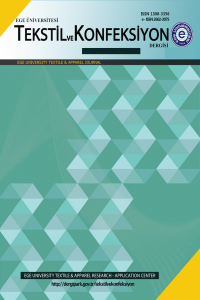Analyzing Efficiency and Productivity Changes of Turkish Textile Firms
Analyzing Efficiency and Productivity Changes of Turkish Textile Firms
Data envelopment analysis, Malmquist productivity index, textile industry Turkey, COVID-19.,
___
- Apan, M., Alp, İ., Öztel, A. (2019). Determination of the Efficiencies of Textile Firms Listed in Borsa İstanbul by Using DEA-Window Analysis, Sosyoekonomi, 27(42), 107-128.
- Caves, D., Christensen, L., Diewert, W.E. (1982). The economic theory of index numbers and the measurement of input, output, and productivity, Econometrica, 50(6), 1393-1414.
- Charnes, A., Cooper, W. W., Rhodes, E. (1978). Measuring the efficiency of decision-making units, European Journal of Operational Research, 2, 429–444.
- Çekiç, B., Menten, C., Atıcı, K.B. (2020). Türkiye Tarım Sektöründe Ürünler Bazında Etkinlik Değerlendirmesi, Verimlilik Dergisi, 1, 117-141.
- Çetin, A. C. (2006). Türk Tekstil Sektörü ve Türk Tekstil Firmalarının Etkinlik Düzeylerinin Belirlenmesi, Afyon Kocatepe Üniversitesi İktisadi ve İdari Bilimler Fakültesi Dergisi, 8(2), 255-278.
- Erdumlu, N. (2016). Efficiency benchmarking based on data envelopment analysis: a case for Turkish textile sector, The Journal of The Textile Institute, 107(6), 702-710.
- Farrell, M. J. (1957). The measurement of productive efficiency, Journal of the Royal Statistical Society, 120, 253-290.
- Gambhir, D., Sharma, S. (2015) Are exporting firms more productive in the Indian textile industry?, Measuring Business Excellence, 19(4), 72-84.
- Gambhir, D., Sharma, S. (2015). Productivity in Indian manufacturing: evidence from the textile industry, Journal of Economic and Administrative Sciences, 31(2), 71-85.
- Goyal, J., Singh, R., Kaur, H., Singh, K. (2018). Intra-industry efficiency analysis of Indian textile industry: a meta-frontier DEA approach, International Journal of Law and Management, 60(6), 1448-1469.
- Ho, C-H. (2013). Applying data envelopment analysis to operating performance in textile industry, AUTEX Research Journal, 13(4), 99-103.
- Jahanshahloo, G.R., Khodabakhshi, M. (2004). Suitable combination of inputs for improving outputs in DEA with determining input congestion considering textile industry of China, Applied Mathematics and Computation 151, 263–273.
- Jiang, L., Folmer, H., Bu, M. (2016). Interaction between output efficiency and environmental efficiency: evidence from the textile industry in Jiangsu Province, China, Journal of Cleaner Production 113, 123-132.
- Kahveci, E. (2012). Kaynak Temelli Strateji ve İhracat Perfonmansı: Tekstil İşletmeleri Üzerinde Veri Zarflama Analizi ile Bir Uygulama, Ankara Üniversitesi SBF Dergisi, 67(2), 29-67.
- Kapelko, M., Lansink, A.O. (2014). An international comparison of productivity change in the textile and clothing industry: A bootstrapped Malmquist index approach, Empirical Economics, 48, 1499–1523.
- Kapelko, M., Lansink, A.O. (2014). Examining the relation between intangible assets and technical efficiency in the international textile and clothing industry, The Journal of The Textile Institute, 105(5), 491-501.
- Kayalıdere, K., Kargın, S. (2004). Çimento ve Tekstil Sektörlerinde Etkimlik Çalışması ve Veri Zarflama Analizi, Dokuz Eylül Üniversitesi Sosyal Bilimler Enstitüsü Dergisi, 6 (1), 196-219.
- Khodabakhshi, M. (2011). Super-efficiency in stochastic data envelopment analysis: An input relaxation approach, Journal of Computational and Applied Mathematics 235, 4576–4588.
- Kıllı, M., Uludağ, S. (2020). Veri Zarflama Analizi ile Maliyet Performansı Ölçümü: BIST Tekstil Sektöründe Bir Uygulama, Business & Management Studies: An International Journal, 8(4), 797-828.
- Kuosmanen, T., Sipilainen, T. (2009). Exact Decomposition of the Fisher Ideal Total Factor Productivity Index, Journal of Productivity Analysis, 31, 137-150.
- Malmquist, S., 1953. Index numbers and indifference surfaces. Trabajos de Estadistica y de Investigacion Operativa, 4, 209-242.
- Ministry of Trade, 2018, www.ticaret.gov.tr/ihracat/sektorler/sanayi-ve-hizmetler (Access: September 2019).
- Nahra, T.A., Mendez, D., Alexander, J.A. (2009). Employing super-efficiency analysis as an alternative to DEA: An applicationin outpatient substance abuse treatment, European Journal of Operational Research, 196, 1097-1106.
- Öztürk, O. Girginer, N. (2014). The export efficiency of Turkish textile and apparel firms: An investigation employing data envelopment analysis (DEA) and analytic hierarchy process (AHP) methods, Tekstil ve Konfeksiyon 25(1), 10-23.
- Perçin, S., Ustasüleyman, T. (2007). Tekstil ve Gıda Sektöründe Etkinlik Ölçümü: Veri Zarflama Analizi ve Malmquist TFP Endeksi Uygulaması, İktisat İşletme ve Finans İnceleme Araştırma Dergisi, 22(250), 154-171.
- Wu, H.X. (2015). Has China’s Fast Industrial Growth Been Efficient? An Industry-Level Investigation with a Newly Constructed Data Set, Applied Economics, 47(40), 4275-4298.
- Yenilmez, F., Girginer, F.N. (2012). Assessing export performance of textile companies in Eskisehir organized industrial zone by use of data envelopment analysis (DEA), Tekstil ve Konfeksiyon, 1, 12-17.
- Yıldız, A. (2007). İmalat Sanayi Şirketlerinin Etkinliklerinin Ölçülmesi, Gazi Üniversitesi İktisadi ve İdari Bilimler Fakültesi Dergisi, 9 (2), 91-103.
- You, S., Yan, H. (2011). A new approach in modelling undesirable output in DEA model, Journal of the Operational Research Society, 62(12), 2146-2156.
- Zhao, H., Lu, X., Yu, T., Yin, Y. (2018). An evaluation model for sustainable development of China’s textile industry: An empirical study, IOP Conf. Series: Journal of Physics: Conf. Series 989, 1-9.
- Zhu, W. Xu, M., Cheng, C-P. (2019). Dealing with undesirable outputs in DEA: An aggregation method for a common set of weights, Journal of the Operational Research Society, DOI: 10.1080/01605682.2019.1568843.
- ISSN: 1300-3356
- Yayın Aralığı: Yılda 4 Sayı
- Başlangıç: 1991
- Yayıncı: Ege Üniversitesi
Analyzing Efficiency and Productivity Changes of Turkish Textile Firms
Başak APAYDIN AVŞAR, Önder BELGİN
Ece KALKANLI TURAN, Belkıs ZERVENT ÜNAL
Investigation on Thermal Comfort Characteristics of Newly Engineered Yarn Umorfil® Knitted Fabrics
Effect of Sewing Thread Properties on Seam Performance of Woven Fabrics
Esra Zeynep YILDIZ, Oktay PAMUK
Nazife KORKMAZ MEMİŞ, Sibel KAPLAN
Imidazolium and Ammonium-Based Ionic Liquids for Reactive Dyeing
Havva Nur ÖZDEMİR, Gülşah Ekin KARTAL, Özgür Yasin KESKİN, Yasemin SEKİ
Copper-Electroplating of Biodegradable PCL Nanofiber Mats
Serkan TEZEL, Sebnem DUZYER GEBİZLİ, Ahd JADOUH, Serpil KORAL KOÇ, Ahmet PEKSÖZ
Poisson’s Ratio of Non-Woven Spun Bonded Fabric for Medical Apparel
